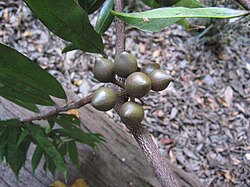Description
It is a tree reaching 3 to 20 meters in height. Its shiny leathery leaves are 7–20 by 2–6.5 centimeters and come to a point at their tips. The leaves are hairless on their upper and lower surfaces, but can have small warty bumps. The leaves are green, greenish brown or dark brown above and brown on their underside. Its petioles are 5-8 millimeters long. Its flowers are solitary or in pairs and axillary. Each flower is on a pedicel 2-5 millimeters long. Its flowers have 3 oval-shaped sepals that are 1.5-3 by 3-5 millimeters. The outer surface of the sepals is densely hairy. Its 6 petals are arranged in two rows of 3. The outer petals are pale green to yellow and 8–11 by 6-10 millimeters. The outer petals are densely hairy on their outer surface. The inner petals are similarly colored, 7–14 by 5-7 millimeters, and concave. The inner petals are smooth on their outer surface except for a hairy patch running from the tip to the base. It has numerous stamens that are 2–3.5 millimeters long. Each flower has 2-20 monocarps that are red, orange, purple or black at maturity and 9-14 millimeters wide. Its brown seeds are 8–12 by 9-11 millimeters. [5]
Reproductive biology
The pollen of P. lucida is shed as permanent tetrads. [6]
This page is based on this
Wikipedia article Text is available under the
CC BY-SA 4.0 license; additional terms may apply.
Images, videos and audio are available under their respective licenses.

